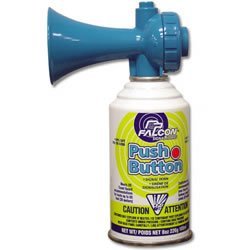More taking the streets...
Yesterday's Toronto Star has an article, "How to have a blast as a pedestrian ," about adding an air horn to the pedestrian arsenal, to let car drivers know when they transgress. It probably works better than yelling, hitting the car, or flipping the finger...
From the article:
The first time I was hit by a car I was more indignant than injured. How dare the driver disrespect me, a lowly walker, going about seven km/h and unprotected by a heated, two-tonne cage of plastic and steel? The city says over 2,300 pedestrians are injured every year in traffic accidents. I'd venture the number is 10 times higher, as not all collisions are reported. Some, like my elbow-slapping courtesy of a car zipping through a four-way stop, are quietly absorbed and recalled only for dinner conversation.

And how many times have people almost been mangled by a rogue automobile? There's no stat on near-misses. These are exponentially scarier during winter months, when roads are ice-slicked and dark nights cloak down early. So to all who fear putting foot to asphalt, listen up: my brother, James, has a preventative safety solution — carry an air horn in your hand while walking and blast the danger-cars.
And the Metro section of the Philadelphia Inquirer had a nice article about traffic calming, "Towns find new ways to tell drivers 'Go slow': Sidewalks grow "bulb-outs," crosswalks get lights similar to those on airport runways, and traffic circles reappear", with many photos (not online) and some links to resources that I will be adding to the section of links from "Dr. Transit", although now they are called "Mobility Links."
 Image from SPARC (Streets for People - a Radnor Coalition website.
Image from SPARC (Streets for People - a Radnor Coalition website.From the article:
It was a typically straightforward kid's question to a parent. "My cousin in Holland can play in the street, and I cannot. Why is that?" Keane te Velde, 6, of Wayne, wanted to know. This was one time a parent, Keane's dad, Bert, had a straightforward answer: Drivers gone wild. Cars flying down residential streets far in excess of the official 25-m.p.h. speed limit are a major traffic problem for many homeowners and police. Simply increasing enforcement is not feasible - there are not enough officers, and serious crime takes priority. So, what can a citizen do?
Some are lobbying area towns to use a European idea called "traffic calming."
It employs a counterintuitive concept - that roads are safer for drivers and pedestrians when an uncertainty factor is incorporated into highway design. That makes driving appear riskier, so motorists slow down. Speed bumps are a crude example. Narrowing a roadway at strategic locations by widening sidewalks is a more sophisticated version. Traffic calming began in the Netherlands in the 1960s as a way to safely integrate cars, pedestrians and bicycles.
One of its founders, Dutch traffic engineer Hans Monderman, was in Wayne recently to help drum up support for a citizens' group founded by te Velde and a half-dozen neighbors. SPARC (Streets for People - a Radnor Coalition) is working with Radnor Township to slow down neighborhood auto traffic.
_______
Another good resource that has really shaped my thinking on these issues is the UK report Living Spaces: Cleaner, Safer, Greener. I haven't read any books by Jan Gehl yet, but he is one of the founders of the walkability movement. In DC, these ideas inform the DC DDOT approach to streetscape improvement, and balancing the focus on all mobility forms, rather than focusing primarily on the car.
Other links in the article are:
PennDot's traffic-calming handbook;
New Jersey's Future in Transportation program;
European "shared-space" movement.
And these definitions of Traffic-Calming Designs and Tactics
Bulb-outs - Curb extensions that narrow a street.
Chicane - A series of three bulb-outs.
Raised median island - At midblock or intersections to narrow streets and provide pedestrian refuge.
Textured crosswalk - Crosswalks constructed to alert motorists to a pedestrian-friendly area.
Speed humps - Three inches high, 12 to 20 feet wide, to slow vehicles to 15 to 20 m.p.h.
Raised crosswalks or intersections - Three to 6 inches high, also to slow vehicles.
Roundabouts - Raised islands at intersections, replacing traffic lights or stop signs. [Note the difference between a traffic circle and a roundabout is that a traffic circle has stoplights.]
SOURCE: Pa.'s Traffic Calming Handbook
Index Keywords: mobility; walking; car-culture



0 Comments:
Post a Comment
<< Home